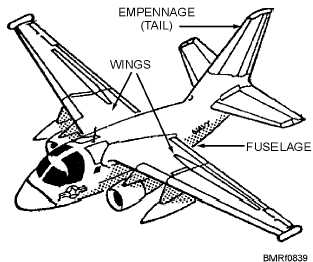50 mph. By contrast, today’s high-performance planes
have speeds in excess of 2,000 mph.
AIRCRAFT NOMENCLATURE
In this section, you will learn the basic parts of
aircraft and how the Navy identifies aircraft.
Fixed-Wing Aircraft Nomenclature
A fixed-wing aircraft (fig. 8-39) may be divided
into three basic parts—fuselage, wings, and empennage
(tail).
FUSELAGE.—The fuselage is the main body of
the aircraft, containing the cockpit and, if there is one,
the cabin. On virtually all naval fighter and attack
aircraft operational today, the engines and some of the
fuel tanks are mounted within the fuselage.
WINGS.—Wings are the primary lifting devices
of an aircraft, although some lift is derived from the
fuselage and tail. Located on the trailing (rear) edge of
the wings are flaps that may be used to give extra lift on
takeoff or to slow the aircraft in flight or landings;
ailerons that control the roll or bank of the aircraft; and
trim tabs used to aerodynamically unload the control
surfaces to relieve some of the pilot’s work. On the
leading (front) edge of the wing may be found
auxiliary lifting devices, resembling flaps, which are
used to increase camber (curvature) of the wing for
added lift on takeoff. Most Navy jet aircraft carry their
bomb loads on pylons (called stations) under the wings
and, in some cases, under the fuselage. Some jets have
missile stations on the sides of the fuselage. Fuel cells
are located in the wings; additional external tanks can
be fitted for extra range. Larger jets may have their
engines slung beneath the wings in pods. Some
low-wing aircraft have their main landing gear retract
into the wings, while the nose wheel retracts into the
fuselage. On most high-wing aircraft all gear retracts
into the fuselage.
EMPENNAGE.—The empennage consists of the
stabilizing fins mounted on the tail section of the
fuselage. These include the vertical stabilizer on which
is generally mounted the rudder that is used to control
yaw, or direction of the nose about the vertical axis; and
the horizontal stabilizer, on the trailing edge of which
are the elevators that determine the pitch (climb or dive).
Some supersonic aircraft may have a full delta wing. In
that case, there is no horizontal stabilizer and the
elevators and ailerons are combined into control
surfaces called elevons.
In aircraft with internally mounted jet engines,
exhausts normally are in the tail. High-performance jets
have afterburners that give additional thrust at the cost
of greatly increased fuel consumption.
Rudder, ailerons, and elevators are collectively
grouped as control surfaces. The “stick” or a similar
device in the cockpit controls these surfaces, while foot
pedals control the rudder. On high-performance
aircraft, aerodynamic pressures on these surfaces
become too great for a pilot to overcome manually;
hence, all high-speed models today have power-assisted
controls.
Rotary-Wing Aircraft Nomenclature
The aerodynamics of rotary-wing aircraft (fig.
8-40) are considerably more complex than those of
fixed-wing aircraft. A helicopter essentially consists of
a fuselage, main rotor or rotors, and often a tail rotor.
FUSELAGE.—As in fixed-wing aircraft, the
fuselage contains the cockpit and cabin.
MAIN ROTOR.—The main rotor is the
approximate equivalent of the wing of a fixed-wing
aircraft. Each rotor blade is an airfoil, like a wing, and
8-33
Figure 8-39. Fixed-wing aircraft.
Student Notes:

